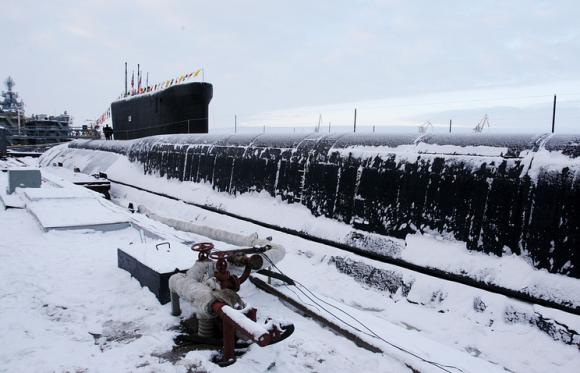The latest nuclear-powered Borei-class submarine, Knyaz Pozharsky, will go into production on 23 December at the Sevmash shipyard in Severodvinsk. The fourth generation Borei-class submarines will form the backbone of the Russian Navy's strategic nuclear deterrent. They will replace Typhoon, Delta-3 and Delta-4 class submarines.
The first three Borei, Project 955, are the K-535 Yury Dolgoruky which joined the Northern Fleet in January 2013, followed by the K-550 Alexander Nevsky at the end of December of that year. The Nevsky is in service with the Pacific Fleet. K-551 Vladimir Monomakh entered service in 2014. Submarines Yuri Dolgoruky and Vladimir Monomakh were assigned to the permanent alert force with patrol missions in the Arctic and around the globe.
The fourth Borei, the Knyaz Vladimir, first of the 955 / A Project, has been under construction since July 2012 at the Sevmash shipyard, in northern Russia. The construction of the fifth nuclear-powered submarine the Knyaz Oleg began in July of the 2014. Work on Generalissimus Suvorov began in December last year. A few weeks later also the seventh Borei, christened Imperator Aleksandr III, entered production at the Severodvinsk construction site. The construction site for the last Borei class submarine and fifth in the A series, the Knyaz Pozharskiy, will be launched on the next 23 December.
Within the 2020, the Russian Navy plans to operate on a total of eight Borei-class ballistic submarines: three 955 and five 955-A. Considering the structural changes, it would not be a mistake to define the 955-A submarines as a Borei-II class.
Designed on a hydrodynamic hull designed to reduce broadband noise emissions, the Borei class is the first in the Russian navy to use pump-jet propulsion. Borei submarines are 170 meters long, with a diameter of 13 meters and a maximum immersion speed of 46 kilometers per hour given by the OK-650 nuclear reactor. The operational depth is attested on the 380 meters (maximum test occurred at 450 meters). Each Borei should carry from sixteen to twenty Bulava missiles (only for 955A), each of which has from six to ten Mirv warheads. The Bulava three-stage missile, code-named Nato SS-N-30 Mace, is the naval version of the most advanced Russian ballistic missile, the SS-27 Topol-M. It can also be launched in motion. It is 12,1 meters long, 2,1 meter diameter and heavy 36,8 tons: it can hit targets up to eight thousand kilometers away and is designed to exclusively equip Borei class nuclear submarines (modifications on the Typhoons were deemed too expensive). The possible coverage of sensitive targets, considering the range of eight thousand kilometers, could be the Barents Sea and the Sea of Okhotsk.
The first Borei, the K-535 Yury Dolgoruky, cost the Russian government 720 millions of dollars, including research and development chapters.
(Photo: Vladimir Larionov / TASS)












